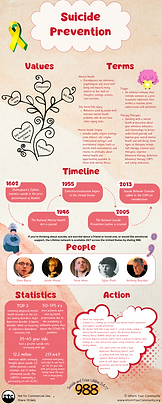
SUICIDE
PREVENTION
In Focus
"See more clearly when you are informed"
Suicide Prevention
Mental health and stigma surrounding it is one of the most pressing issues many Americans are facing today. With limited access and knowledge about mental health services educating yourself and others about Suicide Prevention is instrumental to tackling this issue. Below you will find key terms, statistics, and other useful tools to understand and talk about Suicide Prevention. If you would like to know more, consider coming to an IYC event. Our next one can be found below in the section labeled Our Events. We host them virtually, on a wide range of topics, discussing policy, civics, and current events.
Key Terms You Should Know
Mental Health:
Encompasses our emotional, psychological, and social well-being and impacts many aspects of life, such as thoughts, feelings, actions, and reactions.
Self-harm/Self-injury:
Behaviors used by people with extreme mental health problems who do not have other coping tools.
Therapy/Therapies:
Speaking with a mental health professional about your emotions, behaviors, and relationships to better understand yourself and improve your overall mental health and well-being. Some types of therapies include talk therapy, creative arts therapies, cognitive behavioral therapy, dialectical behavioral therapy (DBT), and taking medication.
Trigger:
An external stimulus that reminds someone of a prior traumatic experience that invokes a reaction, often subconscious and automatic.
Mental Health Stigma:
Includes public stigma (feelings from others), self-stigma (internalized feelings), and institutional stigma (such as hostile work environment), and relates to attitudes about mental health and opportunities available to those with mental illness.

Moments In History
1602 - Shakespeare's Ophelia commits suicide in the first performance of Hamlet.
1955 - Deinstitutionalization begins in the United States.
2013 - Suicide Behavior Disorder added to the DSM for consideration.
1946 - The National Mental Health Act is passed.
2005 - The National Suicide Prevention Lifeline is created.
Statistics
TOP 3 commonly diagnosed mental health disorders in the U.S. are anxiety disorders, major depressive disorder, & bipolar disorder. When co-occurring w/ substance dependence increases risk.
12.2 million American adults seriously thought about suicide, 3.2 million planned a suicide attempt, and 1.2 million attempted suicide, The LGBTQ+ community is particularly at risk (42%).
50-175x's more patients were seen by health professionals due to the availability of telehealth options than before the COVID-19 pandemic.
217,447 estimated emergency visits due to self-harm for 10-24 year olds, with girls/young women having twice the visit rate as boys/young men.
35-45 year olds have a greater suicide rate, increasing with age.
Values
Compassion
Seeking Help

Hopefulness
Self-care
Self-Acceptance/Acceptance of Others
Notable Names





Anthony Bourdain
Janelle Monae
Kevin Hines
Sylvia Plath
Steve Burns
Symbols





Our Events
Past
Future
Further Resources
Popcorn & Chat Event Video
Our film event was insightful and fun! After watching It's Kind Of A Funny Story together, we discussed the film and what we learned about suicide prevention. Feel free to share this video with others! (Not for commercial use.)
Take Action

Increase physical activity and/or start a journal to express your feelings in a safe and private space, using resources such as feeling wheels.

One small action can make a huge difference (Butterfly Effect), such as asking loved ones how you can support them and making it a point to talk about suicide prevention and mental health awareness.

Commit to a weekly act to help raise mental health awareness and support suicide prevention!

No shame! Seek help if you need it - from friends, family, a mental health professional, and/or the National Alliance on Mental Illness (NAMI). Reach out to someone.

Share our Suicide Prevention Infographic with friends, family, and anyone and everyone you think would appreciate becoming more informed!

